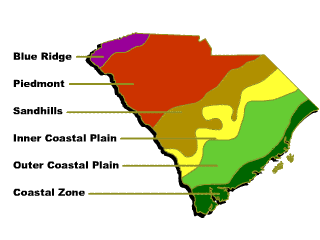
Winter temperatures are much less uniform. In the summer, South Carolina is hot and humid with temperatures during the day averaging near 90 ☏ (32 ☌) across most of the state with overnight lows near 70 ☏ (21 ☌). South Carolina has a humid subtropical climate ( Köppen climate classification Cfa), although high elevation areas in the "Upstate" area have less subtropical characteristics than areas on the Atlantic coastline. The USDA Hardiness Zones for South Carolina range from Zone 7A (0☏ to 5☏) in the extreme northwest portion of the state, to Zone 9A (20☏ to 25☏) along the southeastern coast. Tornadoes are very uncommon in the summer unless a tropical disturbance were to spawn one. Hail and damaging winds often occur in summertime thunderstorms. Tornadoes happen mostly in the spring, with a secondary peak in November. The northwestern area of the state can receive impacts from both Atlantic basin storms moving westward from the coast and also occasionally very heavy rainfall and flooding from storms originating from the Gulf of Mexico that move inland towards the northeast after making landfall from the Florida Panhandle to Louisiana. The coast experiences nearly all of their tropical weather impacts from storms coming directly from the Atlantic coast. Tropical cyclones, and afternoon thunderstorms due to hot and humid conditions, contribute to precipitation during the summer and sometimes fall months, while extratropical cyclones contribute to precipitation during the fall, winter, and spring months. On average, between 40 and 80 inches (1,000 and 2,000 mm) of precipitation falls annually across the state, potentially even in excess of 100 inches in portions of the Appalachian temperate rainforest.

Mild winters predominate in the eastern and southern part of the state, but cool to occasionally cold winters are the standard in the northwestern area of the state, especially areas at or above 600 feet in elevation.

But, an exception does occur in the Blue Ridge Mountains, as outlier pockets of an Oceanic Climate do exist.

South Carolina has a humid subtropical climate, with hot summers throughout most of the State. Köppen climate types of South Carolina, using 1991-2020 climate normals.


 0 kommentar(er)
0 kommentar(er)
